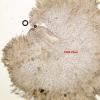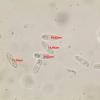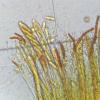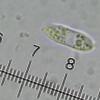
28-09-2023 16:36
Louis DENYBonjour forumTourbière de la Grande Pile. Haute S

28-09-2023 21:32
Karl Soler KinnerbäckI found this Jahnula on submerged wood in freshwat

27-09-2023 16:38
Ismael WindAs mentioned in the title. Someone a clue what thi

28-09-2023 11:02
 Nicolas VAN VOOREN
Nicolas VAN VOOREN
Hello.Can you confirm these two names are synonyms

11-07-2023 08:42
 Miguel Ángel Ribes
Miguel Ángel Ribes
Good morningA friend of mine found this possible a

24-09-2023 20:28
 éric ROMERO
éric ROMERO
Bonjour, Débutant dans le monde des ascomycètes

27-09-2023 17:21
Georges GreiffHi there,I recently noticed tiny, reddish perithec

23-09-2023 14:08
 Laurent Bonneau
Laurent Bonneau
Bonjour, j'ai trouvé ces ascos sur Laissées de s
Hymenoscyphus sur feuille de Betula
Louis DENY,
28-09-2023 16:36
Tourbière de la Grande Pile. Haute Saône.
Blanc, diamètre 1 mm
Aques sans crochet, 100X10 µ
Spores non scutulloides (ou à peine): 14-16 X 5 µ. OCI = 5. Quelques gouttes moyennes et nombreuses petites aux extrémités
Paraphyses avec VB
Semble correspondre à H. caudatus, mais la forme des spores ainsi que leurs dimentions me semblent légèrement différentes.
En parcourant la clé de B. Declercq, j'arrive sur H. betulae, qui semble très voisin.
Merci de me faire part de votre avis
Hans-Otto Baral,
28-09-2023 17:37

Re : Hymenoscyphus sur feuille de Betula
Yes, I have some photos made by Bernard Clesse which look very much like yours and are identified as H. betulae.
In principle, your collection is H. sparsus, but that species I have mainly found on Quercus, rarely Fagus. But: one collection was on Betula (HB 866). In all these finds the lipid content of the spores is rather low, for which reason B. Declercq appears to have separated his species. Whether this is a good character I cannot tell.
Important is also that the VBs in the paraphyses are restricted to the upper 8-25 µm, with only scattered ones further down, in contrast to H. caudatus. And the contents are multiguttulate. This you can see on Boudier's plate. (see my folder sparsus).
In B. Clesse's H. betulae the VBs are more elongated and fill the entire width of the paraphysis, also they reach further down. Both is the case in your find as well.
Louis DENY,
28-09-2023 21:51
Re : Hymenoscyphus sur feuille de Betula
Merci Zotto.
Jean-Luc Ranger,
29-09-2023 08:57
Hans-Otto Baral,
29-09-2023 09:46

Re : Hymenoscyphus sur feuille de Betula
Hmm, this requires a photo of free spores in water to be sure, also spore size.
Hans-Otto Baral,
29-09-2023 12:09

Re : Hymenoscyphus sur feuille de Betula
Yes, this could fit, but one must be cautious, H. caudatus may occur with almost homopolar spores. The contents of the paraphyses seem to confirm your opinion.





 asque-0002.jpg
asque-0002.jpg
